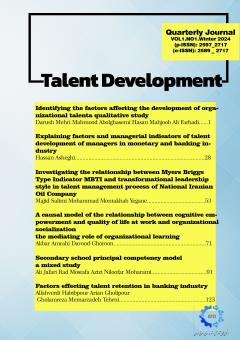Secondary School Principal Competency Model: A Mixed Study
Subject Areas : مدل های شایستگی و اثرگذاری آنها بر توسعه توانمندی های سرمایه های انسانیali Jafari Rad 1 , mostafa Azizi 2 , niloufar Moharami 3
1 -
2 -
3 -
Keywords: Professional development, Competency, Modeling, School Principals,
Abstract :
This study was conducted to design and validate the conceptual model of competence of high school principals in Tehran. For this purpose, a qualitative and quantitative mixed method was used. In the qualitative section, a purposive sample of 17 faculty members, department heads of the Ministry of Education, and some school principals who potentially had the most information about principals' competence were selected. Individuals' views were obtained through semi-structured interviews and open, axial and selective coding was used to analyze the data. The results of the analysis were extracted into 6 main categories including core phenomena, causal factors, contextual factors, interfering factors, strategies and outcomes, and 17 general categories that were addressed in the study. Based on the findings of the qualitative part, a researcher-made questionnaire was designed and was conducted to a sample of 336 secondary school principals in Tehran. Results in quantitative section showed that impact factor values in manager competency measurement model, causal factors- core phenomena (0.137); contextual factors- core phenomena (0.818); interfering factors-core phenomena (0.162); core phenomena- strategies (0.877) and strategies-outcomes (0.896) are desirable. On the other hand, the value of t corresponding to each coefficient is greater than its critical value (1.96) at the significant level of 0.05. Finally, the competency model consisted of factors and components affecting the competence of secondary school principals as a framework and practice guide for education practitioners to select principals.
